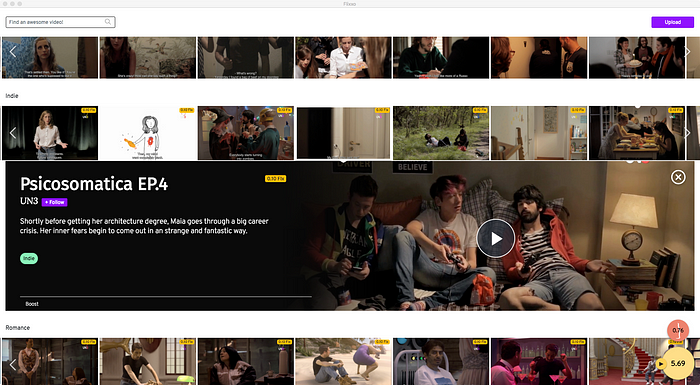It’s been two years since our ICO in October 2017, we’ve been through a Crypto Winter and a cold Crypto Spring, we have dealt with development, studios, producers, crypto media and the centralized mobile app stores, pumps and dumps, new listings and delistings, evangelization and attacks. Our vision, however, remains almost intact. And our enthusiasm for the upcoming milestones is certainly a thrill.
Recap. ICO ended in November and Flixx token started its journey through exchanges. After being traded on EtherDelta, our first listing on a centralized was on Gatecoin (rest in peace), followed by Livecoin and Kucoin and IDEX. The first development team started working in January, with the goal of releasing a first version of the platform in June.
By March 2018, we discovered the universe of Microseries — aka Web series or short form series — while being speakers and sponsors at Buenos Aires WebFest. In April, our CEO Adrian Garelik was invited as a speaker at MIPTV Cannes, one of the biggest content markets in the world, where the first panel about Blockchain and the entertainment industry was held. Also, at MIPTV, we committed over 10,000 hours of content for the platform with FCCE and ZOOMIN.

In June 25th 2018, as expected and after some weeks of zero-sleeping and insane amounts of caffeine, we released our first Flixxo. The platform was really buggy, the UX/UI was far from our expectations, but the core of the technology was functional: blockchain payments over a BitTorrent network. Immediately after the release of the app, Flixx began to be traded at Bancor Network.
We had one of our biggest challenges in October, presenting the app to a broad audience of industry key players at MIPCOM Cannes. We promised something and we wanted to show we have delivered. We faced a redesign of the whole platform, adding a series UX/UI while improving streaming speeds, integrating better analytics and improving the BitTorrent client. NK Studio did an amazing — and award winning — job with the app and our new website.



In June 2019 we released the first mobile version, working only on Android phones. Apple’s app store rejected a first release of the app, arguing that they’d rather not set a precedent of having an app using P2P technologies.
By August, Amazon Web Services welcomed Flixxo to its Activate program, granting USD80K on AWS credits, the second biggest amount for a LATAM based company, and turning Flixxo into the first blockchain based project to receive such recognition.
Bad news for the token, after claiming for a certain minimum trading volume — and even though we reached it — Kucoin decided to delist Flixx. Following the delisting a huge pump and dump process shook the price of the token, which is now pretty stable again and being traded at historical lows.
In September we changed our development strategy, finishing our relationship with Edrans and partnering with Paisanos in order to fully rethink mobile and desktop, and pushing a responsive version of the web app. Part of the team that was previously working for Flixxo on Edrans became full time employees of Flixxo, building a work-synergy together with Paisanos.
In October, again at MIPCOM, Flixxo introduced to the industry the concept of GVOD — for Gamified Video on Demand — a new business scheme aiming to disrupt the incumbent subscription and advertising based models. The repercussion was huge, and we are in conversations with some platforms from all around the world to implement this new model, and our token Flixx as a part of it.
At the same time, also in MIPCOM, we presented our first Flixxo Originals, innovative content in the form of Microseries that will open exclusively on our platform for our mainstream premiere in 2020. Variety magazine was there and published this article about it!
In the last two years we’ve been speakers at MIPTV, MIPCOM and Berlin Film Festival. Also, at Labitconf, Coinagenda and Paris Blockchain Week. We were part of the jury at MIPTV’s Canneseries, Bilbao Seriesland and Die Seriale. We’ve presented the platform and sponsored Berlin Webfest, Rio Webfest, Marseille Webfest, Melbourne Webfest and Buenos Aires Webfest. Our originals, ALT ESC, La Cabeza de San Martin and Neptunia, were nominated at Rio, Bilbao and the Produ Awards. We’ve built a reputation in the universe of microseries, where everybody knows about Flixxo.
Year III
What’s next? We are confident Apple is about to approve the iOS version of Flixxo, as we have temporally bypassed BitTorrent on the iPhone app. Then, an updated version of both Android and iPhone app will see the light of day, including the first concepts of gamification and improvements in the sign up process.
On the other hand, we are already working on the web version. The goal of web is to remove any kind of friction for watching content on Flixxo, even if it means not experiencing the full GVOD or P2P experience. However, this limited version will be an invitation to register and start earning Flixx and enjoying a full Flixxo experience.
Before Q2 2020, staking will be required in order to upload content. Staking to set a security deposit on top of uploaded videos was a concept already explored on the white paper, but we decided to implement it at a later stage in order to allow any content creator to upload their work to the platform. Staking’s goal is to discourage the uploading of low quality or unlicensed videos, and it will be a key step for our token economy.
With exceptional content, original productions and more than 100 series, Flixxo is planning a first mainstream release in Argentina in 2020. Following the release, we plan on expanding to Mexico, Colombia, Chile, Peru and Uruguay. Our goal is to test the model and reach an interesting and sustainable amount of users. Even though we will be focusing our user acquisition to LATAM, the platform and its content will be available worldwide.
Furthermore, we have been researching and doing some empirical testing on the use of P2P technologies for improving worldwide video distribution. Our first impressions were astonishing: a video on Flixxo’s network is likely to use up to 95% less energy than a video on a tradicional CDN — content delivery network — such as Netflix’s or Youtube’s. Such an improvement on energy consumption for video distribution could save 1% of world’s total electricity supply. It could be compared to switching a country the size of Germany off. We are still testing and working to come up with a sustainability report on video distribution.
